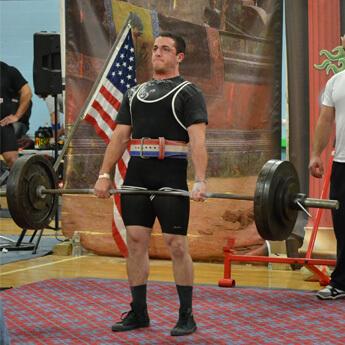Stronglifts 5x5 Workout - Best Strength Training Program for Beginners
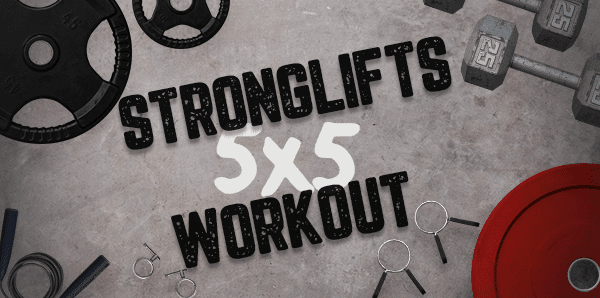
The fitness industry is littered with fad workouts that tell you what to do, how to do it, and promise amazing results. They come. They go. And a new one is born.
The 5x5 workout is not one of those fads. Much like our understanding of the benefits of exercise overall - this training program has stood the test of time having originated in 1960 by the legendary bodybuilder, Reg Park. It has lived on since then.
It has taken on different forms throughout the years into versions with the help of experts like Bill Starr or Mark Rippetoe. But, none of these suit beginners well.
Enter Stronglifts 5x5. This variation is the best 5x5 variation for beginners, as well as one of the best programs for beginners overall.
9 Reasons the 5x5 workout program is so great for beginners
Whatever goal that you may have when it comes to hitting the gym, the 5x5 has you covered. The nine biggest reasons this workout plan is great for beginners only scratches the surface of the benefits of this program.
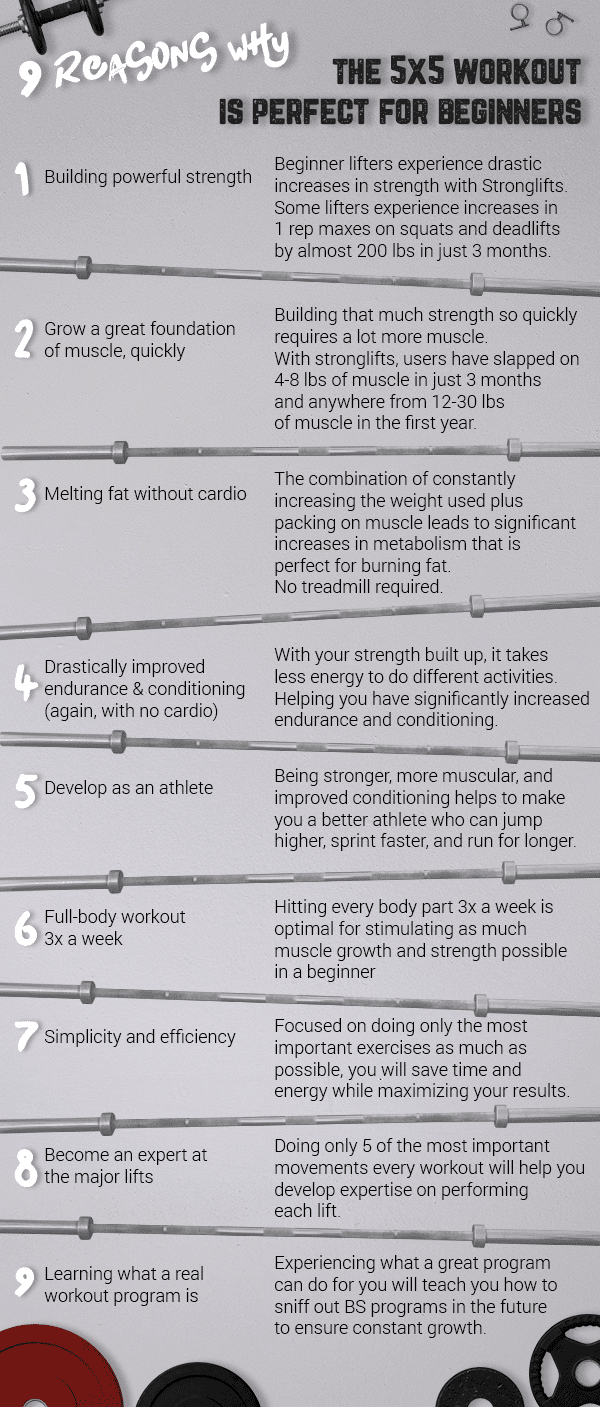
1)Building powerful strength
The primary basis of this program has you add weight every workout to drastically increase strength in the lifter. This is the basis of progressive overload. It forces you to continually adapt to heavy weights each workout, slowly increasing the challenge and your strength.
In fact, in just three months of the program, the average lifter can expect drastic strength gains. Some people have reported increasing their 1 rep maxes on heavier exercises like squats and deadlifts by almost 200 lbs!
2)Grow a great foundation of muscle, fast
The program focuses on strength, yes, but don’t let that fool you. It is also great for muscle building as well. Although you may see programs and “gurus” preach doing high volume or tons of different exercises is the key to gaining muscle, they couldn’t be more wrong.
To increase strength you need to increase what? That’s right, muscle. By consistently improving strength you are consistently increasing your muscle mass as well. In fact, if you haven’t won the genetic lottery or are not using steroids, increasing strength is the only real way to pack on muscle.
How much? Based upon your experience and body type, it is possible to add anywhere from 4-8 lbs of muscle in your first 3 months. And in a year, you could add anywhere from 12-30 lbs of muscle during your first year. For those hard gainers, learn how to start pounding calories or investing in the right nutritional products to help you pack on that additional mass
3)Melting fat without cardio
Yes. You heard it right. Focus on lifting. Burn fat. No cardio. But how?
Firstly, lifting weights requires a great deal of energy. Then there is also the energy required for repairing and building new muscle tissue after every workout. With each workout increasing the weight lifted, you are boosting the amount of energy being burnt every day.
Even if you were eating at a 500 caloric surplus when you first started the 5x5 program, by month 3 that might actually be considered a caloric deficit (which is how weight loss works).
Secondly, since you are packing on muscle, you are going to automatically have a higher basal metabolic rate. Leading to your body’s natural energy requirements to increase. Don't be shocked though if your overall bodyweight doesn't change much. Remember, as you are dropping body fat the program will help you gain muscle which will add to your overall
4)Drastically improved endurance & conditioning (again, with no cardio)
Because you have become exponentially stronger, it takes less energy to do different activities. For example, after spending my first year focused on developing my strength (8 years ago), I started playing soccer for the first time. Having never focused on cardio, I was able to join a local league and had the energy to sustain playing full on 11-on-11 games.
5)Develop as an athlete
No matter what sport you play, getting stronger is going to increase your athleticism. You can expect to be able to jump higher, sprint faster, run for longer, and become a tougher competitor.
6)Full-body workout 3x a week
Most generic programs have you lifting in a way that you target every muscle group once, at most twice, a week. With a full body workout, you are stimulating growth in all muscle groups. Doing this three times a week leads to a maximal stimulus to the entire body. Making it much more effective for building muscle and strength.
7)Simplicity and efficiency
What happens when you cut out all the excess and focus solely on what is going to produce the most bang for your buck? You have an extremely effective program that doesn’t require you to spend hours upon hours in the gym. More results. Less time. Guaranteed.
8)Become an expert at the major lifts
When you are doing the major lifts every single workout you are getting in tons of repetitions. As they say, practice makes perfect. Over the course of 3-6 months of practice, you can expect to become extremely confident in how to perform these compound exercises properly.
9)Learning what a real workout program is
Maybe 6 months or a year from now you decide to try out a different program. Your bullshit meter for what routines are actually effective and what ones are not, becomes fine-tuned. Helping you be more successful whether you are doing this program or not.
What is the Stronglifts 5x5 workout program?
This routine consists of doing 3 full-body workouts a week wtih a very specific rep range for each exercise. What you do on each day is dictated by the alternating “A” and “B” workouts.
Workout A consists of:
- 5 sets of 5 reps of barbell back squats
- 5 sets of 5 reps of barbell bench press
- 5 sets of 5 reps of bent over barbell row
Workout B consists of:
- 5 sets of 5 reps of barbell back squats
- 5 sets of 5 reps of barbell overhead press
- 1 set of 5 reps of barbell deadlifts
For example, on week 1, if you do workout A on Monday, you would rest on Tuesday, and do workout B on Wednesday. It continues alternating workouts from week to week.

Why these exercises?
You don’t see any sort of machine, dumbell, or isolation exercises and that is for good reason. These barbell movements allow you to move the greatest amount of weight possible. With each workout being a full body workout and you moving the greatest amount of weight as possible, you will be able to produce the greatest gains in strength.
In order to increase strength, it requires additional muscle. Making it extremely effective at building muscle mass. Additionally, you are stimulating full body muscle growth 3x a week. In comparison to stimulating each muscle group 1x or 2x a week in your typical upper/lower or body part specific workout routines.
Squat first. Always.
The order that you see the exercises listed isn’t on a whim.
You squat first. Always. This is because squatting is one of the most valuable movements you can do. Studies have actually shown that improving your squat strength increases your natural levels of testosterone and can even increase your bench press 1RM!
Since this is one of the hardest lifts to do, most taxing, and most rewarding, we do it first. This is because if you were to push it to second or third, you will already have expended a great deal of energy. Making it harder to give it your all to continually progress your weight on squats.
So stick to the prescribed order.
Rest up because each set counts!
This workout isn’t a race. The goal is to do every set and every rep. So it is important to rest accordingly in-between sets.
You can determine how long to rest based upon the weight you are using. For example:
- Rest 30-90 seconds in-between sets if the weight is light for you
- Rest 90-180 seconds in-between sets if the weight is a little challenging but not that heavy for you
- Rest 180-300 seconds in-between sets if the weight is heavy for you and pushing towards the upper levels of your strength
By simply resting accordingly you are allowing for your body to be fully prepared to tackle each set. The time in-between allows you to breathe deeply, increasing your oxygen levels. While your resting your body is working to create additional ATP in the muscles. ATP is the currency of energy in the body and is what is responsible for your muscles moving and contracting. The more rest you have, the more ATP can be built, and the greater likelihood of success you have at completing every set.
With a quick overview of what this program is, let’s dig into the details of how to get started.
How to get started with 5x5
Before you start getting into the full swing of things with this program, you need to figure out your one rep max (1RM). The 1RM is used to determine what your starting weights should be for each exercise and how you will progress from workout to workout.
If you have some experience with these exercises you can calculate your 1RM with the tool below. For each exercise, input the amount of weight you have used and the number of reps you were able to do for one set. The tool then calculates what your estimated 1RM is.
For each exercise, you are going to start with 50% of your 1RM.
Here is an example of how that could look based off of calculating a 1RM and then the 50% of that 1RM and then what your first A workout and B workout would look like:
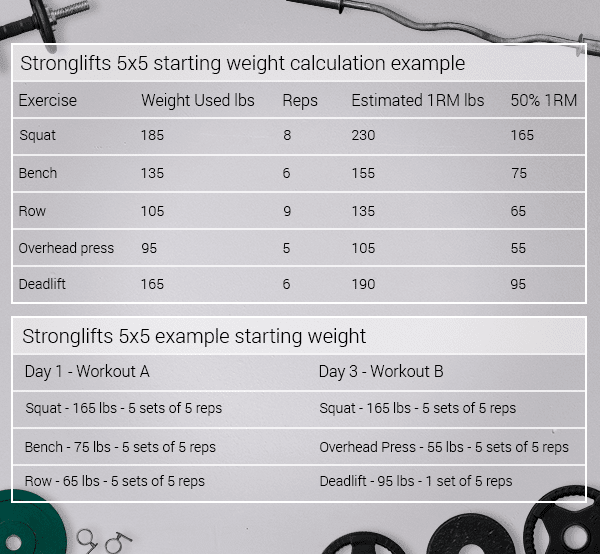
What weights to use if you are a complete newbie
If you aren’t too experienced or as comfortable with these more difficult exercises, you are going to start a little differently. On all 5 exercises, you will start with just using an empty bar (the barbell is 45 lbs).
That may not sound too exciting but this is crucial. It will help you become much more confident with performing these exercises before the weight begins to increase to high. Making sure that you are not only safe but also will be able to confidently continue to increase the weight.
Don’t worry about how it may look working out with just the bar. With how the program progresses from workout to workout you can go from squatting just the bar to squatting over 200 lbs in just 3 months.
What should you focus on while lifting?
There are three aspects of lifting that you want to focus on while you are doing your exercises. If you are able to do all three you will be able to move more weight, progress faster from workout to workout, and increase overall safety.
Lifting tempo
The tempo of a rep speaks to the pacing of how you perform the concentric and eccentric parts of the movement. The tempo can be changed for different desired results.
One result you want is to not waste energy. To avoid this, you want to make sure you are not moving too slowly. Moving slowly increases the time under tension and load on your muscles, depleting you of your energy.
The other result is to move with enough speed and acceleration that helps you build your explosiveness. Hitting that happy goldilocks middle ground allows you to get the best of both worlds.
Breathing
This may seem simple but not breathing properly can drain you of energy and hurt your form. Following the recommended breathing patterns will improve your cardiovascular fitness, enhance your performance, and improve your safety.
What you want to do is to take a deep inhale before each rep. Hold that breath and exhale as you complete the rep. Doing this during a rep will increase abdominal pressure. This supports your core and provides outward pressure towards your back. Supporting your back can help prevent the development of aches and pains or potential injuries in movements like deadlifts or squats.
When you get comfortable with this, you can begin holding your breath for several 2 to 3 reps at a time. Doing this will keep your body tight throughout the duration and further enhance your cardiovascular fitness.
Proper form
The number one rule of lifting weights is that you should never sacrifice proper form for anything. Ensuring you are using proper form with each exercise takes time. Through repetition, you will begin to feel more comfortable and confident with the movement.
What you can do to speed up this process and keep you moving properly is to record yourself lifting. For example, if you are squatting, simply set up your phone to record you from the side. Then utilize high-quality videos and articles that cover how to properly perform these movements to see what you need to work on.
For a complete newbie, this may sound a bit vague but with the right resources and your video, seeing what is going wrong becomes pretty clear. Figuring out ways to improve these issues is as simple as a google search.
Progression and plateaus
By this point, you know what the workout is, what lifts you have to do, what weights to use, and some of the important intricacies of this program. But how do you progress from workout to workout? What determines how you increase the weight as you go? What happens when you hit a wall and are struggling to hit all of your reps and increase the weight?
Let’s find out.
Progression from workout to workout
How this program progresses is dependent on if you are able to complete the 5 reps of your last set on an exercise. If you do then you will increase the weight for the next workout on that exercise.
For example, if you were doing workout B and you were able to do all 5 reps of your deadlift, the next B workout you would use a weight that is 10bs heavier. The amount you increase each exercise is different:
- Squat:
Increase weight by 5 lbs (2x 2.5 lb plates) - Bench Press / Rows / Overhead Press:
Increase weight by 2.5 - 5lbs (2x 1.25 lb plates or 2.5 lb plates). Increasing by 2.5 lbs is highly suggested as it will allow you to continue to progress longer and decrease your chances of hitting a plateau. - Deadlift:
Increase weight by 10lbs (2x 5lb plates). Since the deadlift involves several large muscles you can increase weight at a higher rate. Although, if you begin to struggle to progress as easily, this can be dropped down to 5lbs (2x 2.5 lb plates).
Using the example 1RM from before, your progression through your first two weeks would look like:
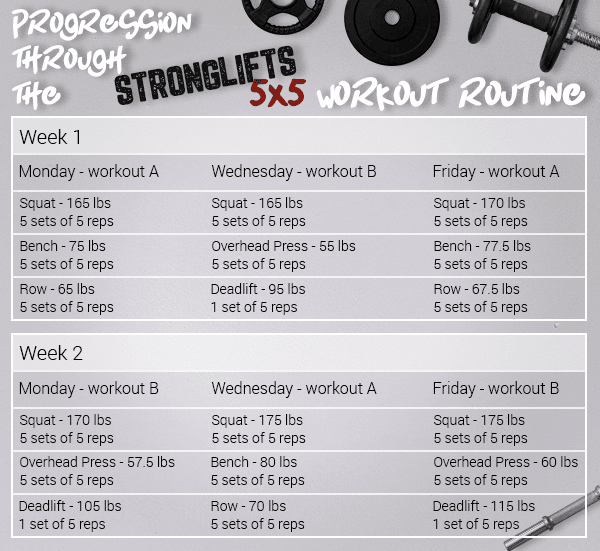
This progression is why it is so important to start with lower weights. If you begin at a 60, 70, or 80 percent of your 1RM you would struggle to progress at the rate you need to. By starting at these lower weights, you are able to build up strength, muscle, and confidence in performing each lift. Minimizing the chances of you hitting a plateau.
What is a plateau and how to break through them
When you start out on your 5x5 journey you will have no problem adding on those weights workout after workout. Eventually, you will likely hit a plateau, which is defined as when you failed to hit all 5 reps on every set of an exercise for 3 workouts in a row.
Most can go months upon months without hitting one. There are a couple of straight forward ways for you to address a plateau. But we save those methods for when you have failed three times in a row. So before we rely on those strategies, you focus on what are some potential causes of those failures.
Whether you like it or not, failure is going to occur. We can’t be 100% all of the time. Sometimes, failing one or two workouts in a row can be turned around before we start treating it as a plateau. So let’s dig into what some potential causes could be of failure.
Common causes of failure
There are some causes that can be in your control and some that are out of your control. Regardless, knowing what these causes may be can help you make any necessary changes. At the very least, you could simply know that it is okay if you failed this time and that you can come back the next work stronger.

Common causes of failure are:
- Too little rest between sets:
If you are going from set to set too quickly you are not allowing your body to recover enough. By simply adding 1-3 minutes of rest between sets can sometimes solve the issue. - Being too active on your “off-days”:
Maybe you are really into cardio, playing sports, or are just an extremely active person. It is important to be generally active on off days to help with recovery but doing too much can leave you overworked. Look to tone down the amount of activity on your off days. - Doing too much additional work in your workouts:
Remember, the program was laid out with just these exercises. It can be okay to add in one or two additional assistance exercises to improve weaknesses but you have to be careful. By simply adding one additional exercise per workout you are increasing the load on your body. Which could be making it so you aren’t recovering fast enough for your following workout. - Not providing your body what it needs to recover or build muscle and strength:
Whether it be a lack of sleep, not drinking enough water, not eating enough, eating too much junk food, or drinking too much alcohol, not providing your body what it needs can significantly hold you back. You would be surprised how simply going from sleeping 7 hours to 8 hours a night can significantly change your progress and performance. - Increasing the weight too fast:
Not everyone is blessed to attend a gym that has 1.25lb or 2.5lb plates. So sometimes, your only option is to add on more weight than you should be. Thankfully, there is an easy solution. Buy your own. You could buy 2x 1.25 lb and 2x 2.5lb plates for under 15 dollars. So instead of upping the weight too fast, leading you to constantly failing, pick up the proper weights you need and bring them with you to the gym. Problem solved. - Not warming up properly:
Warming up is important for getting your muscles active, blood flowing, and getting comfortable with the movements. Properly warming up can be a critical factor in having a great workout. But, like with all things, only in moderation. If you do too much warming up it can border on the line of its own workout. Depleting your muscles energy stores and tiring out your CNS. Get in your 2-3 warm-up sets ramping up to your target weight and get ready to roll.
Sometimes there is no glaring issue. Sometimes you are just not mentally into your workout that day, your stressed out, or maybe even a little sick. But, with this list, you can be sure to reflect and improve what you can to ensure your back at your best come to the next workout.
If you made the necessary changes and you fail 3 times, then you have officially plateaued. To progress past this you are going to use a different strategy.
What to do when you plateau
When you are hitting that plateau on an exercise we have 3 different methods to use to help overcome it. These methods are listed in the order that you should use them. Keeping in mind that you should be addressing the other common causes for failure mentioned above.
- Deloading:
If you failed on the bench press for three “A” workouts in a row, then it is time to deload. This is where you take the amount you of weight you are using and decrease it by 10%.So if you failed on benching 185 lbs for 3 workouts in a row, you would decrease it by approximately 18 lbs (feel free to round up to 20 lbs). So then you would go to your next workout doing 5x5 at 165 lbs. Then continue progressing as normal.
- Take a break:
If you failed at one exercise 3 times, some of your other lifts are struggling, and you have the occasional failure on those lifts, it could be time for a little vacation. Taking a week off and simply focusing on actively recovering can be game-changing. Giving your body a full week of rest will allow you to come back stronger.In fact, this is a normal practice of powerlifters who are competing in competitions. They will do extremely lightweight exercises for the week or so before a meet to allow their bodies to come back even stronger.
- Change the rep scheme:
When the weight starts getting heavier, it becomes way too difficult to continue to increase while still doing 5 sets of 5 reps. You can always deload of course but you can expect to continually hit that plateau. Instead, let’s lighten the load while keeping the weight heavy.Start by doing 3 set of 5 reps (3x5). If that begins to plateau do 3 sets of 3 reps (3x3). Then you can even do less by doing 1 set of 5 reps (1x5) or 1 set of 3 reps (1x3). This is a great way for you to be able to continue on your trajectory and increasing your strength week to week.
Beyond Stronglifts: Madcow 5x5 for intermediate lifters
Unfortunately, all of the amazing progress you will make on the Stronglifts program will start to slow down. You may try doing deloads routinely. Or maybe you have gone as far to go all the way to 1 set of 3 reps on all of your exercises.
The thing is, no matter what you do, at some point, you won’t be able to keep adding on weight every week.
So what are you to do?
Thankfully, as mentioned in the introduction, the 5x5 program has had many variations. What Stronglifts is for beginners, Madcow 5x5 is for intermediate lifters and exactly what you will want to transfer to next.
You can check out this guide for a complete understanding of how to transition from Stronglifts to Madcow.
About RunRepeat
RunRepeat.com helps you find the best training shoes, from Crossfit and weightlifting shoes, to general workout footwear. We do this by delivering in-depth results from our wear tests and lab tests. Lab tests only result in 20+ data points for each shoe, assessing the width, drop, breathability, durability, and other features. If you are going to be starting up the 5x5 training routine or any other workout routine for that matter, check out the science-backed guide to lifting shoes to make sure you are making the right choices in your workout footwear!
